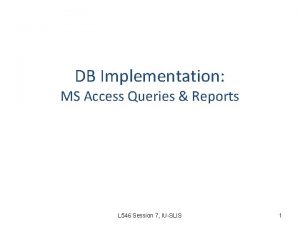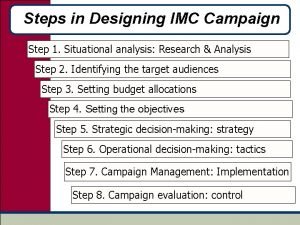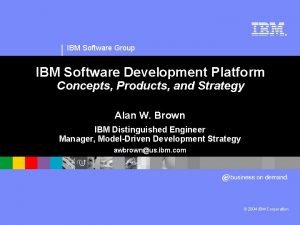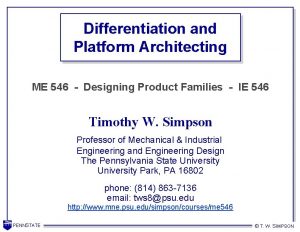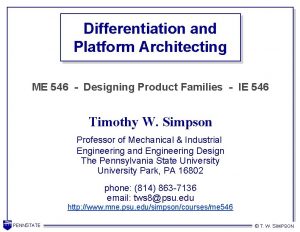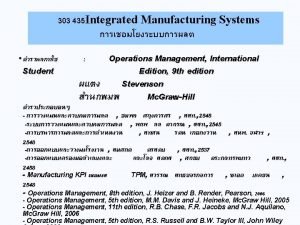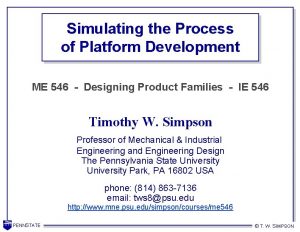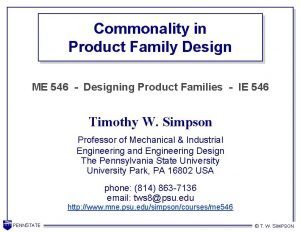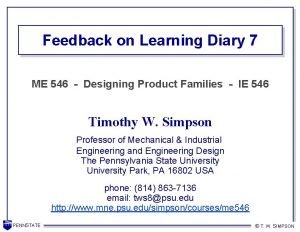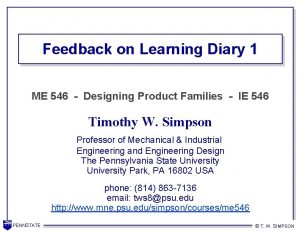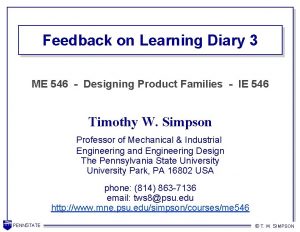Organizing for Effective Platform Development ME 546 Designing




































- Slides: 36

Organizing for Effective Platform Development ME 546 - Designing Product Families - IE 546 Timothy W. Simpson Professor of Mechanical & Industrial Engineering and Engineering Design The Pennsylvania State University Park, PA 16802 USA phone: (814) 863 -7136 email: tws 8@psu. edu http: //www. mne. psu. edu/simpson/courses/me 546 PENNSTATE © T. W. SIMPSON

2 Single-Use Camera Example • Fuji introduced Quick. Snap 35 mm single-use camera in the U. S. market in 1987 • Kodak, which did not have a single-use camera of its own, was caught unprepared • The single-use camera market grew by more than 50 percent per year for the next 8 years: In 1988, 3 million single-use cameras were sold q By 1994, over 43 million were sold q • Kodak introduced its first model over a year later, but Fuji had already developed a second model, the Quick. Snap Flash PENNSTATE © T. W. SIMPSON

Combating the Negative Image of Single-Use 3 • Initially called “Kodak Fling” cameras, single-use cameras viewed as “disposables” or “throwaways” • In 1990 -1991, a massive redesign effort began to facilitate recycling and part reuse q Integrated design, development, manufacturing, business, and environmental personnel to create a new design that was easier to disassemble, inspect, reuse, and reload • By weight, 77 -86% of a Kodak single use camera can be reused or recycled • Kodak now provides the best example of “closedloop” recycling in the world PENNSTATE © T. W. SIMPSON

4 Kodak’s Platform Strategy • From April 1989 and July 1990, Kodak redesigned its base model and introduced three additional models • Because of their platform strategy, Kodak was able to develop its products faster and more cheaply, delivering twice as many products as Fuji • By 1994, Kodak had captured more than 70% of the U. S. market PENNSTATE © T. W. SIMPSON

Teaming for Concurrent Engineering at Kodak PENNSTATE 5 © T. W. SIMPSON

Fun. Saver I Project Timeline (Weeks 21 -40) PENNSTATE 6 © T. W. SIMPSON

Kodak Single-Use Camera Family 7 http: //www. kodak. com/global/en/consumer/film/otuc. shtml PENNSTATE © T. W. SIMPSON

Fuji Single-Use Camera Family PENNSTATE 8 © T. W. SIMPSON

Fuji 35 mm Quick. Snap Camera Family PENNSTATE 9 © T. W. SIMPSON

Fuji 35 mm Quick. Snap Camera Family (cont. ) PENNSTATE 10 © T. W. SIMPSON

Fuji’s Quick. Snap Colors Family 11 http: //www. fujifilm. com/bridgepages/colors. html PENNSTATE © T. W. SIMPSON

Overview of Today’s Lecture 12 • Platform-Based Product Development q Chapter 3 • Development Drivers and Project Frameworks • Risks & Downsides of Platforming PENNSTATE © T. W. SIMPSON

Platform-Driven Product Development (Chp. 3) 13 Source: (Halman, et al. , 2005) PENNSTATE © T. W. SIMPSON

14 ASML Product Roadmap • Product-driven platform-based development of family 3 platforms for 3 market applications q 80% commonality within family; low commonality b/n families q Source: (Halman, et al. , 2005) PENNSTATE © T. W. SIMPSON

15 Skil Product Roadmap • Component-based platform-driven development Product platform for each tool type q 80% commonality within family; 50% commonality b/n families q Source: (Halman, et al. , 2005) PENNSTATE © T. W. SIMPSON

16 SDI Product Roadmap • Technology-driven platform-based development 2 platforms multiple products many market applications q 70 -80% commonality within products of same family q Source: (Halman, et al. , 2005) PENNSTATE © T. W. SIMPSON

Development Drivers vs. Approaches 17 • We can also examine the different “drivers” (e. g. , platform and product) for both top-down and bottom-up approaches to product family design from the companies we have discussed Source: (Alizon, et al. , 2007) PENNSTATE © T. W. SIMPSON

Top-Down Platform-Driven Development 18 Source: (Alizon, et al. , 2007) PENNSTATE © T. W. SIMPSON

Top-Down Product-Driven Development 19 Source: (Alizon, et al. , 2007) PENNSTATE © T. W. SIMPSON

Bottom-Up Platform-Driven Development 20 Source: (Alizon, et al. , 2007) PENNSTATE © T. W. SIMPSON

Bottom-Up Product-Driven Development 21 Source: (Alizon, et al. , 2007) PENNSTATE © T. W. SIMPSON

Examples of Drivers 22 Source: (Alizon, et al. , 2007) PENNSTATE © T. W. SIMPSON

Platform Projects vs. Derivative Projects • Do they differ in terms of product tasks? q 23 Source: (Tatikonda, 1999) Yes, they differ in the amount of new technology development undertaken and project complexity as well as market newness • Do they differ in terms of project success? q No, not in achievement of project objectives, level of company satisfaction, and perceived customer satisfaction or smoothness of project execution • Do they differ in terms of how they are executed? q No, platform and derivative projects generally are executed in similar ways • Do managerial approaches affect project success? q Yes, contingency planning, project-based evaluation of personnel, and overlap of design and manufacturing are associated with higher project execution success for both platform and derivative projects • Does either project type suffer from the use of interdependent technologies and novel project objectives? q Yes, they are associated with project execution failure for platform projects PENNSTATE © T. W. SIMPSON

Platform Projects vs. Derivative Projects (cont. ) 24 • Results are based on interview and survey data from 108 new product development projects from a variety of assembled products industries • Platform and derivative projects differ significantly in their task characteristics and market newness, but do not differ significantly in their planning, execution, smoothness, and success • The results suggest that firms can continue to employ a single product development management process for both platform and derivative projects, as long as modest customization of the process is made for the given project type PENNSTATE © T. W. SIMPSON

25 Recall: Kodak’s Platform Strategy • From April 1989 and July 1990, Kodak redesigned its base model and introduced three additional models • Because of their platform strategy, Kodak was able to develop its products faster and more cheaply, delivering twice as many products as Fuji • By 1994, Kodak had captured more than 70% of the U. S. market PENNSTATE © T. W. SIMPSON

Kodak’s Project Plan 26 Reference: Wheelwright, S. C. and Clark, K. B. Leading Product Development Free Press, New York, 1995. PENNSTATE © T. W. SIMPSON

27 Aggregate Project Planning Process Changes 1 Advanced R&D Projects Product Changes New Core Product Next Generation Process New Core Processes Single Dept. Upgrade Tuning and Incremental 2 Breakthrough Projects Next Generation Product Addition to Product Family Add-ons and Enhancements Source: (Wheelwright and Clark, 1995) PENNSTATE Platform Projects 3 4 Derivatives (Enhancements, Hybrids, and Cost Reduced Versions) 5 Allied Partnerships © T. W. SIMPSON

28 Aggregate Project Plan Classifications • Advanced R&D Projects q Innovations and technology development that provides a precursor to commercial development • Breakthrough Projects q Projects that involve significant change in the product and process establish a new core product and process • Platform Projects q Projects provide a base for a product and process family that can be leveraged over several years • Derivative Projects q Cost-reduced versions of an existing product or platform or add-ons or enhancements to an existing production process • Allied Partnerships q Partnerships in any of these project areas to leverage development resources and activities PENNSTATE © T. W. SIMPSON

29 Aggregate Project Planning at Pre. Quip • Pre. Quip’s Development Projects (30) before the Aggregate Project Plan R&D Breakthrough projects Mass spectrometers Liquid chromatographs Gas chromatographs Data processing and handling products Platform projects Derivative projects R&D Allied and Partnership projects Breakthrough Platform Derivative Source: (Wheelwright and Clark, 1995) PENNSTATE © T. W. SIMPSON

30 Aggregate Project Planning at Pre. Quip • Pre. Quip’s Development Projects (11) after the Aggregate Project Plan R&D Breakthrough projects Mass spectrometers Liquid chromatographs Gas chromatographs Data processing and handling products Platform projects R&D Derivative projects Allied and Partnership projects Breakthrough Platform Derivative Source: (Wheelwright and Clark, 1995) PENNSTATE © T. W. SIMPSON

Management’s Involvement (Traditional) 31 • Traditional Product Development Process q Management involved throughout entire process Source: (Sanchez and Collins, 2001) PENNSTATE © T. W. SIMPSON

32 Risks with Platform-Based Development • ASML q q q Source: (Halman, et al. , 2005) Development time and costs of platform Rigidity in design Restrictions on the integration of new technologies Incorrect forecast of future user needs Change form one platform to another • Skil q q High cost and time for integration of existing elements Platform development becomes easily a goal in itself Mistakes made in the beginning have a high impact Failure to forecast customer needs correctly • SDI q q Development time and costs to meet specifications of all target markets Development process becomes more complex Restrictions for all market segments Selecting the right platform PENNSTATE © T. W. SIMPSON

33 Management’s Involvement (Modular) • Modular Product Development Process q Management involved more at front-end and for integration Source: (Sanchez and Collins, 2001) PENNSTATE © T. W. SIMPSON

34 The Downsides of Platforming • Developing a product platform can cost 2 -10 times more than a single product (Ulrich & Eppinger, 2000) q In automotive industry, up to 80% of total vehicle development cost is spent on platform including engine and transmission (Muffato, 1999); ~ 60% according to (Sundgren, 1999) • Data collected at one firm over a five-year period further showed the platform-based development approach to be negatively correlated with profitability (Hauser, 2001) • Sharing components across low-end and high-end products can increase unit variable costs due to overdesigned low-end products (Gupta & Krishnan, 1998; Fisher, et al. , 1999) • Platforms are not appropriate for extreme levels of market diversity or high levels of non-platform scale economies (Krishnan and Gupta, 2001) • Platform development requires multifunctional groups, and problems may arise over different timeframes, jargon, goals and assumptions (Roberston and Ulrich, 1998) PENNSTATE © T. W. SIMPSON

Planning Product Platforms 35 • Robertson and Ulrich (1998) advocate a three-step approach: 1) Product plan – which products to offer when 2) Differentiation plan – how products will be differentiated 3) Commonality plan – which components/modules will be shared Source: D. Robertson and K. Ulrich, 1998, "Planning Product Platforms, " Sloan Management Review, 39(4), pp. 19 -31. PENNSTATE © T. W. SIMPSON

36 References Cited • Erens, F. , 1997, Synthesis of Variety: Developing Product Families. Eindhoven, The Netherlands, University of Technology. • Fisher, M. L. , Ramdas, K. and Ulrich, K. T. , 1999, "Component Sharing in the Management of Product Variety: A Study of Automotive Braking Systems, " Management Science, 45(3), 297 -315. • Gupta, S. and Krishnan, V. , 1998, "Integrated Component and Supplier Selection for a Product Family, " Production and Operations Management, 8(2), 163 -182. • Hauser, J. R. , 2001, Metrics Thermostat, Journal of Product Innovation Management, 18(3), 134 -153. • Krishnan, V. and Gupta, S. , 2001, "Appropriateness and Impact of Platform-Based Product Development, " Management Science, 47(1), 52 -68. • Lutz, R. A. , 1998, Guts: The Seven Laws of Business that Made Chrysler the World's Hottest Car Company, New York, John Wiley. • Muffatto, M. , 1999, "Introducing a Platform Strategy in Product Development, " International Journal of Production Economics, 60 -61, 145 -153. • Robertson, D. and Ulrich, K. , 1998, "Planning Product Platforms, " Sloan Management Review, 39(4), 19 -31. • Sanchez, R. and Collins, R. P. , 2000, "Competing—and Learning—in Modular Markets, " Long Range Planning, 34(5), 645 -667. • Sundgren, N. , 1999, "Introducing Interface Management in New Product Family Development, " Journal of Product Innovation Management, 16(1), 40 -51. • Tatikonda, M. V. , 1999, "An Empirical Study of Platform and Derivative Product Development Projects, " Journal of Product Innovation Management, 16(1), 3 -26. • Ulrich, K. T. and Eppinger, S. D. , 2000, Product Design and Development, New York, Mc. Graw-Hill, Inc. • Wheelwright, S. C. and Clark, K. B. , 1992, "Creating Project Plans to Focus Product Development, " Harvard Business Review, 70(2), 70 -82. PENNSTATE © T. W. SIMPSON
 Ece 546
Ece 546 Ece546
Ece546 Ece546
Ece546 Rd 546/95
Rd 546/95 Ece 546 uiuc
Ece 546 uiuc 546-528 a.c
546-528 a.c Significant figures of 546 km
Significant figures of 546 km Bc 547
Bc 547 L 546
L 546 Ros smith
Ros smith Output design
Output design Steps in designing hrd programs
Steps in designing hrd programs Designing effective input
Designing effective input Edit2go
Edit2go Steps to situational design
Steps to situational design Designing and developing effective hrd programs
Designing and developing effective hrd programs Textbook design and development procedure
Textbook design and development procedure Ibm software life cycle
Ibm software life cycle Online platforms tools and applications
Online platforms tools and applications Fspos vägledning för kontinuitetshantering
Fspos vägledning för kontinuitetshantering Novell typiska drag
Novell typiska drag Tack för att ni lyssnade bild
Tack för att ni lyssnade bild Vad står k.r.å.k.a.n för
Vad står k.r.å.k.a.n för Varför kallas perioden 1918-1939 för mellankrigstiden
Varför kallas perioden 1918-1939 för mellankrigstiden En lathund för arbete med kontinuitetshantering
En lathund för arbete med kontinuitetshantering Personalliggare bygg undantag
Personalliggare bygg undantag Personlig tidbok
Personlig tidbok Sura för anatom
Sura för anatom Vad är densitet
Vad är densitet Datorkunskap för nybörjare
Datorkunskap för nybörjare Tack för att ni lyssnade bild
Tack för att ni lyssnade bild Mall för debattartikel
Mall för debattartikel Autokratiskt ledarskap
Autokratiskt ledarskap Nyckelkompetenser för livslångt lärande
Nyckelkompetenser för livslångt lärande Påbyggnader för flakfordon
Påbyggnader för flakfordon Lufttryck formel
Lufttryck formel Offentlig förvaltning
Offentlig förvaltning








